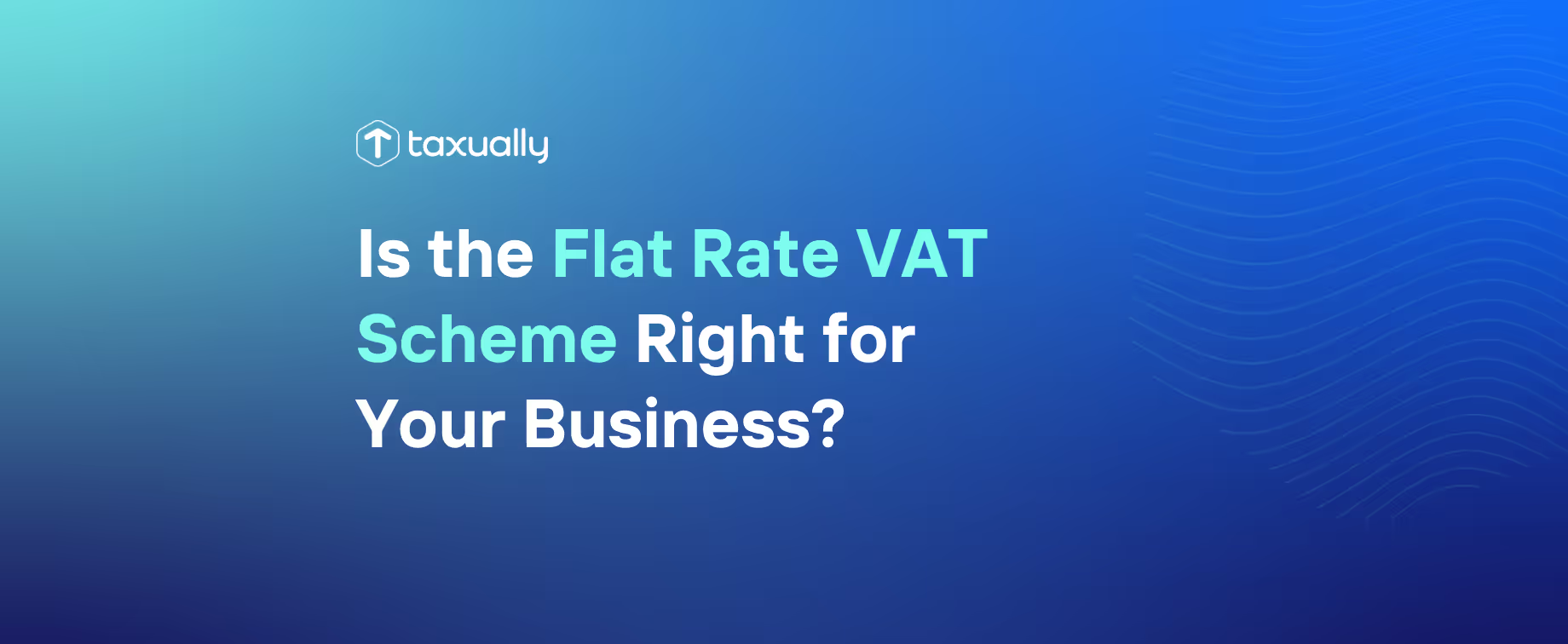Key takeaways
- The VAT Flat Rate Scheme offers simplified calculations and reduced paperwork for small businesses with an annual turnover of £150,000 or less.
- Special rates are available to industries affected by COVID-19, while limited-cost businesses have a higher rate of 16.5%.
- Careful sector selection and compliance with regulations can help maximize the benefits of the scheme.
Are you struggling with complex VAT calculations and mountains of paperwork? As a small business owner, it’s essential to find ways to simplify your financial processes and focus on growing your business. Enter flat rate VAT schemes, a solution designed to streamline your VAT calculations and save you valuable time.
In this guide to flat rate VAT schemes, we take a closer look at its benefits and drawbacks, and how to determine if it’s the right option for your business. With expert tips and insights into recent regulatory changes, you’ll be well-equipped to make an informed decision and potentially maximize your profits.
Understanding the VAT Flat Rate Scheme
The VAT Flat Rate Scheme offers a simplified method for calculating and paying VAT to HM Revenue & Customs (HMRC). Instead of adding up all the VAT you charge your customers (output VAT) and subtracting the VAT you can reclaim on your purchases (input VAT), your sales are totaled, and a fixed percentage is applied to that amount, which you then pay to HMRC. This scheme is specifically designed for small businesses, with eligibility limited to those with an annual turnover of £150,000 or less, excluding VAT.
New businesses can enjoy a one percent reduction in VAT through the Flat Rate Scheme, calculated for 12 months from the date of VAT registration, not the date of joining the scheme. This reduction can be a valuable advantage for startups looking to minimize their tax liabilities in their first year of operation as a vat registered business.
Key features of the scheme
One of the main attractions of the VAT Flat Rate Scheme is its simplicity. Instead of dealing with intricate VAT calculations, businesses pay a fixed rate percentage to HMRC based on their business type. This reduces the administrative burden and provides small businesses with a more predictable and manageable VAT payment structure, with the VAT charged at a flat rate.
Another key feature of the VAT Flat Rate Scheme is the reduced paperwork involved. As you’re not required to keep track of input VAT on every purchase, the scheme lightens the burden of record-keeping and allows business owners to focus on what truly matters – growing their business. Additionally, new businesses can benefit from a one percent reduction in VAT during their first year of trading.
Determining your business's VAT inclusive turnover

VAT inclusive turnover is an important factor for businesses using the Flat Rate Scheme. It refers to the total value of your sales that are subject to VAT, including the VAT amount charged to customers. To calculate your VAT inclusive turnover, simply add the VAT amount to your VAT taxable turnover, which is the value of your sales subject to VAT (excluding sales exempt from or outside the scope of VAT).
Understanding your VAT inclusive turnover is essential for businesses using the Flat Rate Scheme, as it determines the percentage of sales you’ll need to pay to HMRC. By accurately calculating your VAT inclusive turnover, you can ensure compliance with the scheme’s requirements and avoid any potential underpayments or overpayments of VAT.
Joining the VAT Flat Rate Scheme
You must meet certain criteria to join the VAT Flat Rate Scheme. Firstly, your business must be VAT-registered. Secondly, you need to expect your VAT taxable turnover to be £150,000 or less in the next 12 months. If your annual turnover exceeds this threshold, you may consider other VAT schemes or standard VAT accounting to manage your VAT obligations.
Registering for the VAT Flat Rate Scheme is easy. All you have to do is submit your details to HMRC. You can complete the online application form VAT600FRS or apply via post, phone, or email.
With eligibility confirmed and registration completed, you can begin reaping the benefits of simplified VAT calculations and potentially reduced VAT payments.
Assessing your business type and flat rate percentage
To ensure accurate VAT payments under the Flat Rate Scheme, you must choose the correct flat rate percentage for your business. The fixed rate percentage depends on your business type, with various rates available for different sectors. For example, a textile manufacturer would pay a 9% fixed rate, while a hairdressing and beauty treatment business would pay a 13% rate.
In addition to the standard rates, special rates have been introduced for industries affected by COVID-19, providing further relief for businesses in these sectors.
Special rates for COVID-19 affected industries
The UK government implemented temporary reduced VAT rates for the tourism and hospitality sector to support industries most impacted by COVID-19. A temporary 5% reduced rate was extended until 30th September 2021, followed by a 12.5% reduced rate until 31st March 2022. After this deadline, businesses in the affected industries reverted to the standard 20% VAT rate.
These special rates provide much-needed relief for businesses in the tourism and hospitality sector, allowing them to navigate the challenging economic landscape created by the COVID-19 pandemic as the business pays less.
Limited cost businesses and the 16.5% rate

Limited cost businesses are those that do not purchase many goods, while limited cost traders are those whose VAT inclusive expenditure on goods is either less than 2% of their VAT inclusive turnover in a designated accounting period or greater than 2% of their VAT inclusive turnover but less than £1,000 per annum. In 2017, a higher VAT rate of 16.5% was introduced for limited cost businesses to prevent exploitation of the Flat Rate Scheme for economic gain.
To determine if your business is liable for the higher VAT rate, calculate whether your goods cost less than 2% of your VAT inclusive turnover or £1,000 per year. The limited cost trader test should be conducted each time a VAT return is submitted to ensure compliance with the Flat Rate Scheme regulations.
Pros and cons of the VAT Flat Rate Scheme
There are several advantages to using the VAT Flat Rate Scheme, such as simplified accounting, reduced paperwork, and the potential for decreased VAT payments. However, one main drawback of the scheme is the inability to reclaim VAT on purchases, except for certain capital assets above £2,000.
Before deciding to join the Flat Rate Scheme, you should weigh the pros and cons carefully. Consider whether the amount of VAT that can be reclaimed from your monthly expenses would outweigh the reduction in cost you receive from participating in the scheme. If your business produces a significant amount of VAT exempt sales, zero-rated sales, or procures a substantial amount of standard-rated goods and services, the VAT cost of joining the scheme may be higher than using other VAT schemes or standard VAT accounting. For these reasons, you should analyze your business situation before you decide to join the scheme.
Managing VAT returns with the Flat Rate Scheme
To maintain compliance and avoid potential penalties, it's necessary to efficiently manage your VAT returns while using the VAT rate scheme. A variety of digital record-keeping and software options are available to assist with this process, as well as specialist VAT software.
To submit a VAT flat rate return, enter the VAT payable to HMRC in Box 1, which is calculated by multiplying your total turnover (including VAT) by the VAT flat rate percentage. By utilizing digital tools and adhering to the guidelines for submitting VAT returns, you can ensure your business remains compliant and benefits from the simplified VAT calculation process offered by the Flat Rate Scheme.
Navigating regulatory changes in the VAT Flat Rate Scheme
Recent regulatory changes in the VAT Flat Rate Scheme have introduced a new category known as the ‘limited cost trader,’ which affects the flat rate percentage for businesses that do not purchase many goods. Another notable change in June 2022 focuses on the handling of import VAT for Flat Rate Scheme traders utilizing postponed VAT accounting. The appropriate handling excludes the value of imported goods from the Flat Rate Scheme computation, and the full amount of import VAT should be added to Box 1 after the flat rate calculation.
Staying informed about regulatory changes and their implications is crucial for businesses using the VAT Flat Rate Scheme. By keeping up-to-date with these developments, you can ensure your business remains compliant and continues to benefit from the scheme’s advantages.
Expert tips for maximizing benefits from the Flat Rate Scheme

To maximize the benefits of the Flat Rate Scheme, be sure to select the appropriate sector for your business and remain compliant with VAT regulations. Thoroughly research the various sectors and their associated flat rate percentages to guarantee that the correct sector is chosen for your business type.
Accurate record-keeping is also vital for maximizing the benefits of the Flat Rate Scheme and ensuring compliance with VAT regulations. By maintaining precise records of all transactions and invoices, you can avoid potential penalties and ensure your business reaps the full benefits of the simplified VAT calculation process.
Conclusion
The VAT Flat Rate Scheme offers small businesses a simplified method for calculating and paying VAT, reducing their administrative burden, and potentially allowing for increased profits. By understanding eligibility requirements, the registration process, and the various flat rate percentages, businesses can make an informed decision about whether the scheme is right for them.
While the Flat Rate Scheme may not be suitable for every small business, those that meet the eligibility criteria and carefully weigh the pros and cons can benefit from the streamlined VAT calculation process and focus on growing their business. With the right expertise and insights into recent regulatory changes, companies can remain compliant and maximize the benefits of the Flat Rate Scheme.
Do you need help with your VAT compliance? Book a free call with one of our VAT experts to find bespoke solutions for your business, optimize your VAT costs, and reach millions of new potential customers.
Frequently asked questions
New Year's Day - 1/1/2024Memorial Day - 5/27/20244th of July - 7/4/2024Labor Day - 9/2/2024Thanksgiving Day - 11/28/2024Day after Thanksgiving - 11/29/2024Christmas Eve - 12/24/2024Christmas Day - 12/25/2024
What is a flat rate scheme?
The Flat Rate Scheme is a simplified system for smaller businesses, allowing them to pay a fixed percentage of their total sales to HMRC.
The difference between the amount charged to customers and the amount paid to HMRC is kept by the business.
What is the disadvantage of the Flat Rate Scheme?
The main disadvantage of the Flat Rate VAT Scheme is that the fixed-rate percentages do not take into consideration any zero-rated and exempt sales, meaning businesses will pay more VAT if they mainly sell these types of goods and services.
This can be a significant issue for businesses that rely on these types of sales, as they will be paying more VAT than they would under the standard VAT scheme.
Who is eligible for VAT flat rate scheme?
Businesses that are VAT registered and have an annual turnover of £150,000 or less (excluding VAT) are eligible for the VAT Flat Rate Scheme, allowing them to save time from tracking purchases.
Under the scheme, businesses pay a fixed rate of VAT on their total sales, rather than the standard rate. This rate is lower than the standard rate, meaning businesses can save money.
The scheme is designed to simplify the process of calculating and paying VAT, making it easier to calculate and pay VAT.
Should I go on the Flat Rate Scheme?
The Flat Rate Scheme can help save time and reduce administrative work, so it’s worth considering. It can streamline your cash flow and simplify your accounting records, leaving you more time to focus on running your business.



















